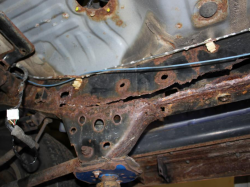
— A Toyota 4Runner rusted frame investigation won't be initiated after a 4Runner owner petitioned the National Highway Traffic Safety Administration to investigate alleged premature frame corrosion on more than 520,000 model year 2002-2006 Toyota 4Runners.
The petition to investigate was submitted in August 2018 by 2005 Toyota 4Runner owner Gary Weinreich a few months before he filed a class action lawsuit against Toyota alleging front suspension failures in 2005-2011 4Runners.
According to the defect petition, Weinreich referenced frame rust and suspension failure complaints filed by 4Runner owners. He also referenced his own experience with his 4Runner, along with a class action lawsuit settlement that involved rusted frames on Toyota Tacoma, Tundra and Sequoia trucks.
However, Toyota 4Runner SUVs were not included in the settled lawsuit.
Federal safety regulators studied his complaint as well as frame rust and underbody corrosion complaints from other Toyota 4Runner customers. NHTSA also researched the facts related to the Toyota rusted frame settlement referenced by the petitioner.
The 2005 Toyota 4Runner owned by the petitioner had severe corrosion first discovered by a Toyota dealer in 2011 that indicated damage caused by seawater. The dealer invoice said the 4Runner had, “severe and excessive amount of rust on the undercarriage and on the drive shaft transmission.”
Two years later another dealer found the underbody corrosion damage was worse than before, with “rust on shocks/struts and other components,” “rust on exhaust system,” “both splash shields severely rusted,” and “undercarriage very rusty.”
Four years after that, in July 2017 and about 10 months before the suspension failure, an independent repair shop discovered “excessive frame corrosion” on the 2005 Toyota 4Runner.
To determine if an official safety defect investigation should be opened, NHTSA found 15 complaints about front lower control arm failures in fourth-generation Toyota 4Runners.
"Two of the failures, including the petitioner’s SUV, involve vehicles were operated in ocean front communities with continuous exposure to aerosolized marine salts and potential exposure to seawater immersion. The remaining thirteen failures all involved vehicles owned or previously registered in states with the greatest use of deicing salts to treat road surfaces in winter months." — NHTSA
Safety regulators also determined front control arm failures typically occurred after the Toyota 4Runners had been in service 13 years in highly corrosive environments.
NHTSA denied the defect petition because the "service history, severe general corrosion damage, failure age, and environment do not support the petitioner’s allegation of premature corrosion failure."
The Toyota 4Runner class action lawsuit filed by the petitioner is still being argued in court.




